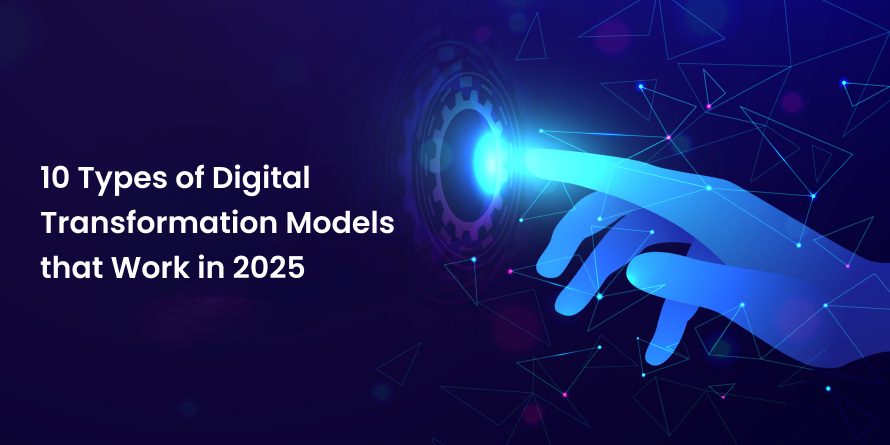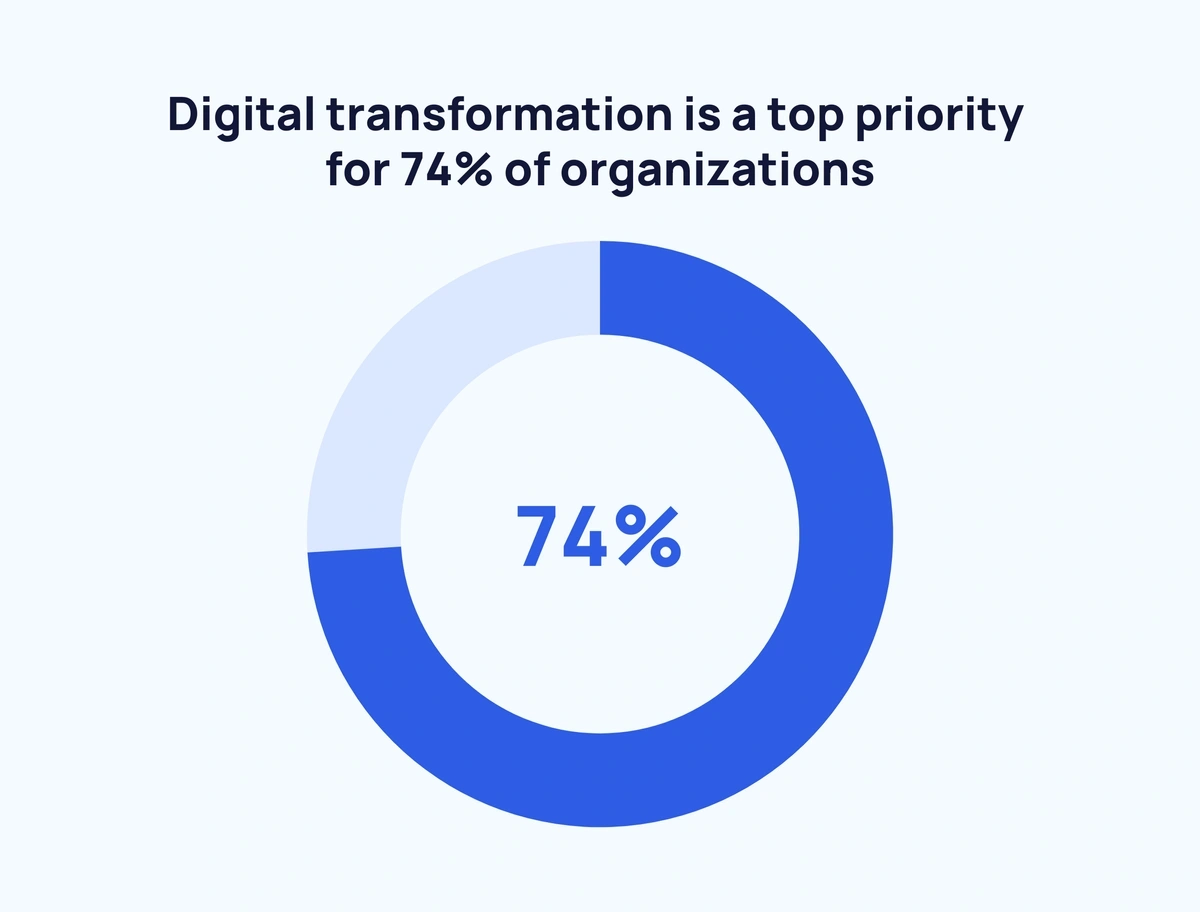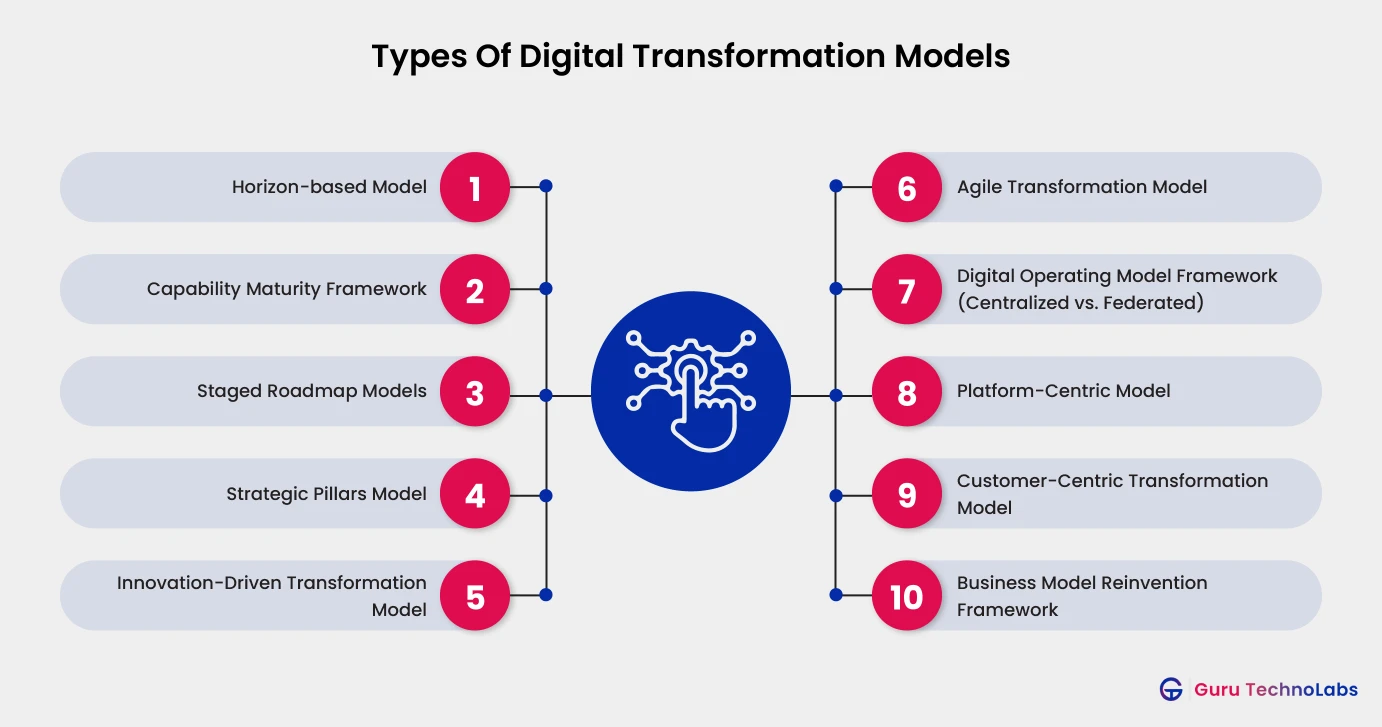10 Types of Digital Transformation Models that Work in 2025

Are you wondering which digital transformation model is right for your business? In a world where digital disruption is the norm, choosing the right transformation strategy can make or break your success. From streamlining operations to enhancing customer experiences, the right digital transformation model helps businesses adapt, innovate, and grow.
In this blog, we’ll explore the top 10 digital transformation models that are driving innovation across industries, from AI-powered workflows to customer-centric frameworks. Whether you’re a startup or an enterprise, understanding these models can help you make smarter decisions and stay competitive in 2025 and beyond.
Plus, we’ll share real-world examples from companies like Amazon, Netflix, Siemens, and Domino’s to show how these models work in action.
What Is The Digital Transformation Model?

A digital transformation model is a strategic framework that helps businesses plan, implement, and manage digital change.
It outlines the steps, technologies, and mindsets needed to shift from traditional operations to digital-first processes. These models are used by companies of all sizes to stay relevant, improve efficiency, and deliver better customer experiences.
For example, a retail company might use a customer-centric transformation model to improve its mobile shopping app and personalize user interactions through AI.
In short, digital transformation models act like a roadmap, guiding your business through innovation, tech upgrades, and cultural change in a structured way.
Why Does The Digital Transformation Model Come Into Play?
The Digital Transformation Model has become a critical strategic tool for organizations aiming to remain relevant and competitive in today’s fast-evolving digital landscape.
According to Research and Markets, the global digital transformation market is projected to reach $1009.8 billion by 2025, growing at a CAGR of 16.5%, showing just how vital digital innovation is across all industries.
With rapidly changing customer expectations, disruptive technologies, and a demand for business agility, companies are turning to digital transformation services to improve commercial performance and build future-ready operations.
Staying updated with the latest Digital Transformation Trends not only helps organizations adapt but also ensures they stay ahead of competitors.
A strong transformation model provides a clear roadmap for adopting technologies like AI, cloud computing, IoT, and automation, driving operational efficiency, customer satisfaction, and scalable growth.
10 Types Of Digital Transformation Models

Digital transformation isn’t a one-size-fits-all approach. Each business faces unique challenges, customer expectations, and market conditions, which means different models will work best for various organizations. In this section, we’ll explore 10 types of digital transformation models that are shaping the future of modern businesses.
1. Horizon-based Model
The Horizon-Based Model is a popular strategy for digital transformation. It helps businesses make changes in stages, starting with improving current operations and moving toward future innovation. It’s perfect for companies that want to grow steadily while still performing well today.
The Three Horizons Explained:
Horizon 1: Improve What You Already Do
This stage is about making your current business better using digital tools.
Common actions:
- Moving to the cloud
- Automating daily tasks
- Making processes faster and more efficient
Horizon 2: Find New Growth Areas
This step looks at exploring new markets and income sources using modern technologies.
Key technologies:
- Artificial Intelligence (AI)
- Big Data and Analytics
- Internet of Things (IoT)
Horizon 3: Focus on Future Innovation
This is about preparing for big changes and creating new ways of doing business.
Focus areas:
- Augmented Reality (AR) and Virtual Reality (VR)
- Machine Learning
- New digital business models (like B2B, B2C, and C2C platforms
Benefits
- Breaks transformation into manageable steps
- Balances today’s goals with tomorrow’s growth
- Supports both small improvements and big innovations
Challenges
- You’ll need to manage your budget carefully across all stages
- Don’t focus too much on short-term fixes and forget about long-term vision
If you’re searching for a digital transformation model that allows you to innovate without disrupting your current operations, the Horizon Model is a proven framework. It’s especially useful for enterprises planning phased digital growth.
2. Capability Maturity Framework
The Capability Maturity Model (CMM) is a step-by-step framework that helps businesses measure and improve how mature their digital transformation efforts are. It shows where you currently stand and what you need to do to get better.
How It Works
- Level 1 – Initial: Processes are unorganized, and things are done on the fly without a clear plan.
- Level 2 – Managed: Some project management practices are in place to add structure and consistency.
- Level 3 – Defined: Processes are clearly documented, standardized, and followed across the company.
- Level 4 – Quantitatively Managed: Decisions are made based on data and performance metrics.
- Level 5 – Optimizing: Focus is on ongoing improvements and innovation to stay ahead.
- Gives a clear roadmap to grow your digital maturity
- Helps spot weak areas that need improvement
- Lets you compare your progress with industry standards
- Takes time and effort to fully implement
- Needs strong company-wide commitment to follow the process
Benefits
Challenges
If you’re looking for a structured and measurable path to digital maturity, the Capability Maturity Model is ideal. It helps large organizations assess and improve their digital capabilities step by step.
3. Staged Roadmap Models
The Phased or Staged Roadmap Model breaks digital transformation into clear, manageable steps. Each stage has a specific goal, helping businesses make progress without feeling overwhelmed.
How It Works
- Stage 1 – Assess: Check your current digital strengths and weaknesses.
- Stage 2 – Plan: Create a clear roadmap for your digital transformation.
- Stage 3 – Implement: Start making small changes in technology and processes.
- Stage 4 – Scale: Expand and improve digital efforts across the organization.
- Stage 5 – Innovate: Keep adapting and bringing in new ideas to stay ahead.
Benefits
- Breaks transformation into simple, doable steps
- Keeps everyone on the same page and tracks progress easily
- Focuses on small wins, which reduces risk
Challenges
- Delays can happen between stages
- May become too rigid, limiting quick decisions
If your business wants to take a safe, step-by-step approach to digital transformation, the Phased Roadmap Model is a smart choice. It’s especially useful for small and mid-sized businesses just starting their digital journey.
4. Strategic Pillars Model
The Strategic Pillars Model focuses on the main areas (called “pillars”) that support your business goals during digital transformation. These usually include technology, people, operations, and customer experience.
How It Works
- Choose Your Pillars: Decide which areas (like tech, culture, or customer service) are most important for your transformation.
- Build Initiatives: Create action plans for each pillar to support your digital goals.
- Track and Improve: Regularly measure how each pillar is doing and make improvements.
Benefits
- Balances focus between tech and people
- Keeps transformation aligned with your business strategy
- Promotes teamwork across different departments
Challenges
- Needs strong leadership to keep everything coordinated
- If teams work in silos, pillars may not work well together
If you want your digital transformation to match your overall business strategy, the Strategic Pillars Model is a great option. It helps you focus on the right areas—like people, processes, and technology—to drive success across all departments.
5. Innovation-Driven Transformation Model
The Innovation-Driven Model puts innovation at the heart of digital transformation. It focuses on using new technologies to create unique products, services, or business models.
How It Works
- Encourage Experimentation: Build a company culture where trying new ideas is supported.
- Invest in Innovation: Set up R&D teams or innovation labs to explore new possibilities.
- Use Emerging Tech: Leverage technologies like AI, blockchain, and IoT to create big changes in the market.
Benefits
- Helps your business stand out from the competition
- Allows fast adaptation in a changing market
- Opens up new ways to earn revenue
Challenges
- New ideas may fail, which carries risk
- Needs a lot of investment and skilled talent
If your business wants to lead with bold ideas and use the latest tech to disrupt the market, the Innovation-Driven Model is a powerful approach. It’s ideal for startups or companies focused on cutting-edge innovation.
6. Agile Transformation Model
The Agile Transformation Model uses Agile principles to guide digital transformation. It focuses on being flexible, working closely as a team, and delivering value quickly in small steps.
How It Works
- Break Work into Small Steps: Split big projects into smaller parts that can be done quickly.
- Work as a Team: Use cross-functional teams that share ideas and give regular feedback.
- Focus on the Customer: Keep customer needs at the center and adjust quickly when things change.
Benefits
- Speeds up project delivery
- Keeps everyone involved and aligned
- Lowers risk by testing and improving often
Challenges
- Requires a shift in company culture to embrace Agile thinking
- May be difficult for companies with traditional management styles
If your organization values speed, teamwork, and flexibility, the Agile Transformation Model is a great fit. It’s ideal for tech companies or fast-moving digital teams that want to innovate continuously and respond quickly to change.
7. Digital Operating Model Framework (Centralized vs. Federated)
This model looks at how digital work is organized in a company—either through a single team (centralized) or spread across departments (federated).
How It Works
Centralized Model
- One team handles all digital efforts
- Creates a clear strategy and faster decisions
- Helps standardize tools and processes
Federated Model
- Digital work is spread across departments
- Teams have more freedom to create solutions that fit their needs
- Encourages more innovation at the local level
Benefits
- Centralized: Better control, consistency, and efficiency
- Federated: More innovation and quicker responses to local needs
Challenges
- Centralized: Can slow down new ideas due to too much control
- Federated: May lead to repeated work and lack of alignment
If your company wants a balance between strong control and flexible innovation, this model helps define who makes digital decisions. It works best for large companies with multiple departments or locations.
8. Platform-Centric Model
This model is popular in SaaS and digital-first companies. It focuses on building a strong digital platform that supports many products and services in one place.
How It Works
- Build a Scalable Platform: Create a flexible system that can grow and handle more users, features, and tools.
- Add Features Quickly: Easily connect new features and third-party services to the platform.
- Focus on User Experience: Keep improving the platform to give users a smooth and connected experience.
Benefits
- Helps you grow fast and add new services easily
- Keeps customers engaged with an all-in-one experience
- Makes it easier to use data for smarter decisions
Challenges
- Needs a big investment at the start
- Managing security and rules for the platform can be complex
If your business is SaaS-based or focused on digital products, the Platform-Centric Model is a smart choice. It supports long-term growth by creating a powerful, user-friendly digital ecosystem.
9. Customer-Centric Transformation Model
This model puts the customer at the center of digital transformation. It focuses on improving customer experience (CX) and making interactions more personal and meaningful.
How It Works
- Use Customer Data: Collect feedback and data to understand what customers want.
- Personalize Everything: Customize products, services, and communication to fit each customer.
- Support from Inside: Make sure your internal processes and teams are aligned to deliver great CX.
Benefits
- Increases customer happiness and loyalty
- Boosts sales with personalized offers and experiences
- Helps your business stand out from the competition
Challenges
- Needs strong data and analytics systems
- Requires teamwork across all departments to stay focused on CX
If your main goal is to improve customer experience, the Customer-Centric Model is a great fit. It’s ideal for B2C industries like retail, hospitality, and travel where personalization and engagement matter most.
10. Business Model Reinvention Framework
This model focuses on changing how your business creates value and earns money by using digital technologies.
How It Works
- Review Your Current Model: Look at what’s not working or could be improved.
- Find New Opportunities: Explore new ways to offer value, make money, and form partnerships.
- Make the Shift: Use digital tools to update or completely change your business model.
Benefits
- Helps you discover new growth paths
- Prepares your business for future changes in the market
- Makes your company more flexible and strong
Challenges
- Requires big changes across the organization
- If not handled carefully, it could upset current customers
If you’re rethinking how your business operates and makes money, this model helps you transform at a deeper level. It’s perfect for older or traditional companies facing digital disruption.
Struggling to Choose the Right Digital Transformation Model?
You’re not alone. Many businesses face challenges like outdated systems, disconnected teams, and slow growth. But with the right model, transformation becomes achievable and successful.
What You’ll Get with Digital Transformation Consultation
1. Expert guidance on choosing the right transformation model
2. Personalized roadmap to match your unique business needs
3. Proven strategies to increase efficiency, innovation, and growth
Digital Transformation Models Examples
Here are 5 real-world examples of digital transformation models in action, showing how top companies apply them for growth and innovation:
1. Horizon-Based Model – Microsoft
Microsoft used the Horizon Model to strategically evolve its business from traditional software to cloud and AI-driven solutions. Initially, the focus was on optimizing core products like Windows and Office. Next, they expanded into cloud computing with Azure and Office 365, creating new revenue streams. Finally, they invested heavily in emerging tech like AI, mixed reality, and quantum computing to disrupt future markets.
2. Capability Maturity Model – IBM
IBM leverages the Capability Maturity Model to systematically assess and improve its digital capabilities across IT, security, and operations. By progressing through maturity levels, IBM ensures continuous improvement in processes and technology adoption, which helps maintain a competitive advantage and operational excellence. This structured approach reduces risks and aligns digital transformation with business goals.
3. Agile Transformation Model – Spotify
Spotify’s agile transformation is famous for creating autonomous teams called squads, tribes, and guilds, enabling rapid innovation and iterative product development. This model empowers teams to quickly respond to user feedback and market changes while maintaining alignment with company-wide objectives. It fosters a culture of collaboration, experimentation, and fast delivery.
4. Platform-Centric Model – Amazon Web Services (AWS)
AWS exemplifies the Platform-Centric Model by providing a cloud infrastructure platform that supports millions of developers and businesses worldwide. This ecosystem approach allows customers to build, deploy, and scale digital products quickly, benefiting from shared resources and innovation. AWS’s platform-centric strategy drives network effects and continuous growth.
5. Customer-Centric Transformation Model – Netflix
Netflix leads with a customer-centric model by prioritizing personalized user experience through data-driven recommendations and seamless streaming. Their digital transformation emphasizes continuous improvement of the content delivery platform and user interface, keeping engagement high and churn low. Personalization and CX innovation remain at the core of Netflix’s growth.
Factors to Consider When Choosing a Digital Transformation Model
The choice of digital transformation model should be based on the direction, resources, and state of the business environment. This model should let your company envision growth and address the complexities of the evolving business environment.
Therefore, if you have to go about selecting a change model, there are various elements you have to consider to ensure that you find the right model that can easily aid in achieving future business goals.
Company Goals and Vision
Appreciating your brand’s vision down the road and goals in the short term is imperative. The model you choose must underpin these goals so that transformation initiatives are focused on delivering your intended objectives.
Current Market Conditions
Think about how things are changing in the market. A successful transformation model will assist you in responding to changes in the industry and the behaviour of consumers, thus keeping up with the demand.
Resources and Capabilities
Consider time and money for the business, the types of technology you have, and the availability of professional staff. Select the transformation model relevant to your capacity and consider your financial and operational capacity.
Customers’ Requirements and Expectancy
You need to ensure you adapt to your customer’s needs as they change. Therefore, A business transformation must be customer-focused, that is, applied to improve a customer experience and ensure you are meeting or exceeding your competitors in this area.
Risk and Change Management
There is always a risk in every change process. It makes it easier to define the possibility of experiencing some challenges and plan effective change management. Select a model that would enable you to minilmize various risks in the process and ensure a smooth transition throughout the process.
Want a Trusted Partner for Your Digital Transformation
Journey?
Let’s make things easier. We’ll help you plan, build, and grow with the right
digital strategy—tailored just for you.
1. We listen to your business goals
2. We build solutions that actually work
3. We stay with you from start to finish
Adapt the Right Digital Transformation Model Seamlessly with Guru TechnoLabs
In today’s fast-paced and competitive business world, digital transformation is no longer optional, it’s essential. No matter the size or industry, businesses must adopt the right digital models to stay relevant and ahead of the curve. At Guru TechnoLabs, we recognize the challenges that come with this shift and specialize in delivering custom digital transformation solutions designed to maximize your ROI while minimizing disruption.
Wherever you are in your digital journey, we’re here to support you. Our team of expert designers and developers collaborates closely with you to craft and implement tailored digital transformation strategies that align with your unique business goals. With years of experience and a proven track record, we offer end-to-end custom software solutions, from initial ideation and strategy discussions to flawless execution, helping you accelerate your digital transformation initiatives with confidence.
How We Help Your Business Thrive:
- Digital Strategy Development: Crafting a clear, actionable roadmap tailored to your vision and goals.
- Technology Integration: Seamlessly embedding modern technologies to boost efficiency and enhance customer engagement.
- Change Management: Guiding your team through transitions to ensure smooth adoption and minimal resistance.
- Continuous Improvement: Ongoing evaluation and optimization to keep your business agile and competitive.
As a leading digital transformation partner, Guru TechnoLabs empowers you to navigate complexity with ease, so you can confidently embrace the future, unlock new opportunities, and grow your business sustainably.
Frequently Asked Questions
A digital transformation model is a set of principles or strategies that help companies properly implement digital technologies and trends.
Digital transformation is vital because it helps companies adapt, increase productivity, and meet consumers’ demands. It also enables businesses to cope with constantly shifting market factors and trends and avoid a short existence.
The best model selection depends on several factors, including business objectives, existing market conditions, available resources, and customer preferences. Contact us, and our expert will help you choose the best model that aligns with your business goals and will yield fruitful results in the years to come.
It is common for organizations to face issues such as resistance to adoption, the lack of a skilled workforce, compatibility with other systems, and high implementation costs.
"Types" refer to areas like process, cultural, or customer experience transformation, while "models" are frameworks or methods to carry out that change.





















